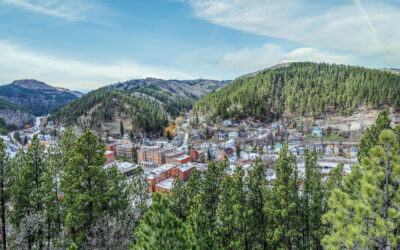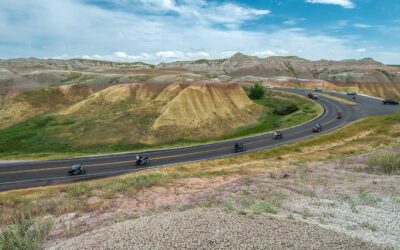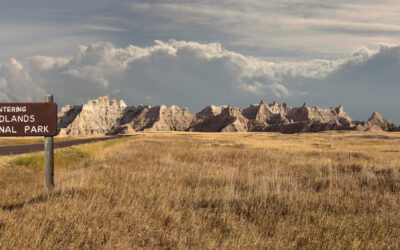Badlands National Park, a geological wonder nestled in the rugged heart of South Dakota, offers a unique blend of striking landscapes and abundant wildlife. This article, ‘Unveiling the Rugged Majesty of Badlands National Park,’ takes readers on a journey through the park’s untamed terrain, its seasonal spectacles, and the incredible opportunities it presents for wildlife encounters and photography.
Key Takeaways
- Badlands National Park is a prime destination for adventurers seeking to explore its distinctive Notch Trail and fossil-rich beds.
- The park provides a sanctuary for diverse wildlife, including bighorn sheep, bison, prairie dogs, and numerous bird species.
- Visitors can experience the park’s dynamic beauty through seasonal changes, from vibrant spring wildflowers to the stark beauty of winter snows.
- Photographers will find a paradise in Badlands, with opportunities to capture stunning sunrises, the golden hour’s light, and celestial night skies.
- With its hidden gems and must-do activities, Badlands National Park ranks as a top location for those looking to experience the majesty of untouched nature.
Exploring the Untamed Terrain
Hiking the Notch Trail
The Notch Trail is a must-visit for any adventurer seeking to experience the raw beauty of Badlands National Park. This 1.5-mile round trip hike offers a unique blend of challenging terrain and breathtaking vistas. The trail is well-marked and begins with a leisurely walk through a canyon, leading up to a log ladder that climbers must navigate to reach the upper section of the trail.
Once atop, hikers are rewarded with panoramic views of the White River Valley. The trail’s end point, ‘The Notch’, provides a dramatic overlook that is particularly stunning at sunrise or sunset. It’s important to note that the trail can be treacherous with loose gravel and steep drop-offs, so appropriate footwear and caution are advised.
Here’s a quick guide to ensure a safe and enjoyable hike:
- Check weather conditions before setting out, as the trail can become slippery when wet.
- Bring plenty of water, as the arid climate can lead to dehydration.
- Stay on designated paths to protect the fragile ecosystem and your own safety.
- Consider a morning hike to avoid the intense afternoon heat and to capture the best light for photographs.
Whether you’re an experienced hiker or just looking for an unforgettable adventure, the Notch Trail delivers an exhilarating encounter with the untamed wilderness of the Badlands.
Discovering Fossil Beds
Badlands National Park offers a unique window into the ancient past, with its fossil beds revealing secrets from millions of years ago. Delve into the paleontological richness of the park by exploring areas where remains of ancient mammals have been meticulously preserved. The fossil beds are not only a testament to the park’s historical significance but also a hub for ongoing scientific research.
Visitors can engage with the latest findings at the park’s visitor centers, where displays and interactive exhibits bring the prehistoric world to life. For those looking to dig deeper, the park often hosts talks by scientists, such as the recent discussions at Agate and Badlands by four female researchers. Their work on fossilized mammals provides fascinating insights into the creatures that once roamed this rugged landscape.
To fully appreciate the fossil beds, consider these tips:
- Visit the Ben Reifel Visitor Center to start your journey with educational resources.
- Join a ranger-led program to gain expert knowledge on the park’s paleontological treasures.
- Explore the designated trails that offer views of the fossil beds, ensuring not to disturb the delicate sites.
Whether you’re a science enthusiast or simply curious about the natural world, the fossil beds of Badlands National Park are a must-see attraction that promises a journey back in time.
Stargazing at Cedar Pass
As night falls over Badlands National Park, Cedar Pass emerges as a premier destination for stargazing enthusiasts. The absence of light pollution allows for an unobstructed celestial showcase, revealing the Milky Way in all its splendor. The park’s open skies and high elevation create ideal conditions for observing constellations, planets, and meteor showers.
To make the most of your stargazing experience, consider these tips:
- Check the lunar calendar to plan your visit during a new moon for darker skies.
- Bring a red-filtered flashlight to preserve your night vision.
- Use a star chart or an app to help identify celestial objects.
- Dress warmly and bring blankets or chairs for comfort during long observation sessions.
Amateur astronomers and casual observers alike will find Cedar Pass a tranquil spot to connect with the cosmos. Whether you’re capturing long-exposure photographs or simply soaking in the vastness of the universe, the memories made under the Badlands’ night sky are sure to be unforgettable.
Wildlife Encounters and Where to Find Them
Bighorn Sheep and Bison Spotting
Badlands National Park serves as a sanctuary for some of America’s most iconic wildlife. The park’s expansive mixed-grass prairie is home to a diverse array of animals, but it’s the bighorn sheep and bison that often steal the show for visitors. These majestic creatures embody the untamed spirit of the Badlands, and spotting them is a highlight for any wildlife enthusiast.
To increase your chances of encountering these animals, timing and location are key. Early morning or late afternoon are prime viewing times, as the animals are most active during the cooler parts of the day. For bison, the Sage Creek Wilderness Area is a hotspot, while bighorn sheep are frequently seen in the rocky regions near Pinnacles Overlook.
Here’s a quick guide to help you plan your wildlife watching adventure:
- Early Morning: Best time for active wildlife.
- Late Afternoon: Animals are often out grazing.
- Sage Creek Wilderness: Known for bison sightings.
- Pinnacles Overlook: A favorite spot for bighorn sheep.
Remember to keep a safe distance from all wildlife and respect their natural habitat. With a little patience and some luck, you’ll be rewarded with a memorable encounter that highlights the rugged beauty of Badlands National Park.
The Prairie Dog Towns
Badlands National Park is a sanctuary for the charismatic prairie dogs, and the park’s prairie dog towns are a must-see for wildlife enthusiasts. These bustling colonies are home to hundreds of these social rodents, offering a unique glimpse into their intricate lives.
Visitors can observe the prairie dogs as they forage, play, and communicate with one another through a complex system of vocalizations and body language. The best spots to watch these engaging creatures are the Roberts Prairie Dog Town and the Sage Creek Basin, where the animals are accustomed to human presence and can be viewed from a safe distance.
To enhance your prairie dog town experience, consider these tips:
- Visit during the early morning or late afternoon when prairie dogs are most active.
- Keep a respectful distance to avoid disturbing their natural behavior.
- Use binoculars or a zoom lens for a closer look without getting too close.
- Stay on designated paths to protect both the wildlife and the fragile Badlands ecosystem.
Birdwatching Bonanza
Badlands National Park offers a birdwatching experience that is as diverse as its landscape. With the park’s rugged terrain serving as a backdrop, birders can spot a variety of species that make this habitat their home. From the sharp call of the Burrowing Owl to the majestic soar of the Golden Eagle, the park is a haven for avian enthusiasts.
The park’s unique ecosystem supports a rich birdlife, including raptors, songbirds, and migratory birds. Here’s a quick guide to some of the birds you might encounter:
- Burrowing Owl: Often found around prairie dog towns, these small owls are known for their ground-dwelling habits.
- Golden Eagle: Keep an eye on the sky for these impressive hunters, especially around the park’s higher elevations.
- Prairie Falcon: Another bird of prey, the Prairie Falcon, can be seen darting over the grasslands in search of small rodents.
Birders and non-birders alike watch for other wildlife with the expected species being bison, pronghorn, bighorn sheep, mule deer, and black-tailed prairie dog. Whether you’re a seasoned birder or just enjoy the occasional feathered sighting, Badlands National Park is a destination that should be on your list.
Seasonal Spectacles of Badlands
Spring Blooms and Wildflower Walks
As the harsh winter subsides, Badlands National Park undergoes a remarkable transformation. The arrival of spring breathes life into the arid landscape, ushering in a season of renewal and growth. Visitors are greeted by a vibrant tapestry of wildflowers, each species uniquely adapted to the park’s challenging environment. The spectacle is not only a feast for the eyes but also a crucial period for the local ecosystem.
The park’s diverse flora includes species such as the weakstem mariposa lily and the desert five-spot, which bloom in an array of colors and shapes. To fully appreciate this seasonal display, consider embarking on one of the park’s designated wildflower walks. These guided tours offer an immersive experience, allowing you to learn about the flowers’ ecological roles and survival strategies.
For those keen on documenting the wildflower season, here’s a quick checklist to enhance your visit:
- Bring a field guide to identify the various species.
- Wear comfortable walking shoes for the uneven terrain.
- Carry water and sun protection, as the Badlands can be deceptively sunny.
- Use the park’s wildflower report as a reference for the most recent blooms.
Embrace the opportunity to witness the park’s fleeting beauty, as the wildflower season is a brief but glorious window into the resilience of nature in the Badlands.
Summer Storm Watching
The Badlands are renowned for their dramatic summer storms, offering a spectacle that is both awe-inspiring and a reminder of nature’s raw power. Thunder rumbles across the prairie as dark clouds gather, creating a stunning contrast against the jagged landscape. Visitors are encouraged to observe these storms from safe vantage points, as the park’s open spaces can quickly become hazardous.
Safety should always be your top priority when storm watching. Here’s a quick checklist to ensure you’re prepared:
- Check the weather forecast before heading out.
- Stay informed about park alerts and warnings.
- Avoid open areas and seek shelter if necessary.
- Keep a safe distance from wildlife, as animals can behave unpredictably during storms.
Experiencing a summer storm in the Badlands can be a highlight of your visit, offering a unique opportunity to witness the dynamic interplay between the land and the elements. Just remember to respect the power of these natural events and prioritize your safety at all times.
Autumn Colors and Winter Wonders
As the vibrant greens of summer fade, Badlands National Park transforms into an autumnal palette of golds, oranges, and reds. The park’s grasslands and spires take on a new life, offering a visual feast for visitors. This seasonal shift is not just a treat for the eyes; it’s a unique time for wildlife activity as animals prepare for the colder months ahead.
With the arrival of winter, the Badlands present a starkly beautiful landscape, now blanketed in snow. The crisp air and clear skies provide perfect conditions for winter hiking and photography. Visitors should be prepared for the cold and potentially challenging conditions, but those who brave the elements are rewarded with serene vistas and a peaceful park experience.
To make the most of your visit during these seasons, consider the following tips:
- Dress in layers to adapt to the unpredictable weather.
- Check the park’s website for trail closures and weather advisories.
- Bring along a thermos of hot beverage to stay warm during your explorations.
Remember, while the park’s beauty is accessible year-round, the experience is ever-changing with the seasons. Embrace the opportunity to witness the Badlands in its autumn and winter glory.
Photographer’s Paradise
Capturing the Sunrise at Pinnacles Overlook
The first light of dawn at Badlands National Park offers a breathtaking spectacle, especially from the vantage point of Pinnacles Overlook. Photographers gather here in the pre-dawn silence, setting up their tripods to capture the first golden rays as they illuminate the rugged spires and deep canyons. The key to a successful sunrise shoot is preparation and timing. Here are a few tips to ensure you get that perfect shot:
- Arrive early: You’ll want to be in position at least 30 minutes before sunrise. This gives you ample time to set up and enjoy the tranquility of the park at dawn.
- Check the weather: Clear skies are ideal for capturing the vibrant colors of sunrise, but don’t be discouraged by a few clouds; they can add drama to your photos.
- Scout your spot: Visit Pinnacles Overlook during the day to find the best composition for your sunrise photo.
- Use a tripod: This is essential for stability during low light conditions.
- Play with settings: Experiment with different shutter speeds and apertures to capture the varying intensities of light.
As the sun crests the horizon, the landscape transforms, revealing the contours and textures that make the Badlands a photographer’s dream. Remember to respect the park’s environment and wildlife while you’re immersed in capturing its beauty. After the sunrise, take the opportunity to explore Badlands National Park in South Dakota further, with its ancient rock formations, fossils, and rich history. Each region, from Western to Central to Eastern South Dakota, offers unique experiences that are sure to enhance your photographic journey.
The Golden Hour Glow
The golden hour at Badlands National Park is not just a time; it’s a transformative experience. As the sun hovers near the horizon, the landscape ignites with warm hues that photographers dream of capturing. The interplay of light and shadow during this time accentuates the rugged textures of the park, offering a brief window where every rock formation and crevice seems to tell its own ancient story.
To make the most of the golden hour, here’s a quick checklist:
- Check the local sunset times and plan to arrive at least 30 minutes earlier.
- Scout for the perfect location during the day. The Pinnacles Overlook is a popular choice, but don’t be afraid to explore lesser-known spots.
- Bring a tripod for stability and consider using a graduated ND filter to balance the sky and land exposure.
- Be patient and ready to adapt; the best light can come and go in a matter of minutes.
Remember, the golden hour isn’t just about the light; it’s about the atmosphere it creates. Taking in a sunset somewhere near the Sage Creek turn off as the golden light transforms the landscape all around you is something you can never be prepared for, but you’ll always remember. It’s a moment where time seems to stand still, and the beauty of Badlands National Park reveals itself in full splendor.
Night Photography Tips
Badlands National Park transforms into a celestial dome as night falls, offering photographers a chance to capture the cosmos. The absence of light pollution makes it an ideal spot for night photography, with the Milky Way often visible to the naked eye. To ensure a successful night shoot, consider the following tips:
- Scout your location during the day to find the perfect composition and to navigate safely at night.
- Use a tripod to stabilize your camera for long exposures.
- Employ a wide-angle lens to capture the vastness of the night sky.
- Set your camera to manual mode to have full control over the exposure settings.
- Utilize a remote shutter release or your camera’s timer to avoid camera shake.
Remember to check the weather forecast and moon phases before planning your shoot, as clear skies and a new moon are preferable for capturing the stars. Lastly, dress warmly and bring extra batteries, as the cold can drain them quickly. With preparation and patience, the Badlands at night can yield truly stunning images.






